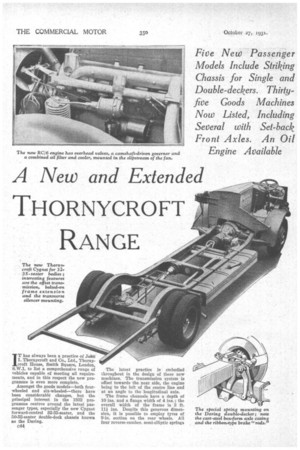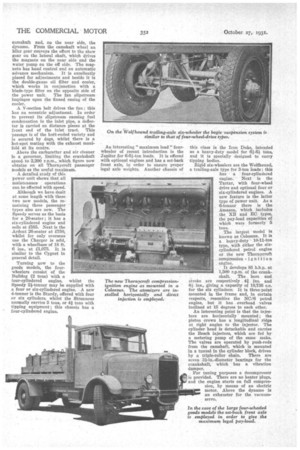A New and Extended
Page 94

Page 95

Page 96

If you've noticed an error in this article please click here to report it so we can fix it.
TH ORNYCRO FT RANGE
Five New Passenger Models Include Striking Chassis for Single and Double-deckers. Thirty five Goods Machines Now Listed, Including Several with Set-back Front Axles. An Oil Engine Available
IT has always been a practice of John I. Thornycroft and Co., Ltd., Thornycroft House, Smith Square, London, S.W.1, to list a comprehensive range of vehicles capable of meeting all requirements, and in this respect the new programme is even more complete.
Amongst the goods models—both fourwheeled and six-wheeled—there have been considerabld changes, but the principal interest in the 1982 programme centres around the latest passenger types, especially the new Cygnet forward-control 32-3Z-seater, and the 50-52-seater double-deck chassis known as the Daring.
c44
The latest practice is embodied throughout in the design of these new machines. The transmission system is offset towards the near side, the engine being to the left of the centre line and at an angle to the longitudinal axis.
The frame channels have a depth of 10 ins, and a flange width of 4 ins. ; the overall width of the frame is 3 ft.
ins. Despite this generous dimension, it is possible to employ tyres of 9-in. section on the rear wheels. All four reverse-camber, semi-elliptic springs are carried below the main members in order to give the maximum stability. The difference between the single and double-deck types lies principally•in the rear extension; in both cases it is bolted on. Behind the front wings are two substantial pressed-steel body bearers, which should be welcomed by the coachbuilder.
As regards lateral bracing of the frame, the front cross-member is quickly detachable; it carries rubber buffers for both the radiator and the U-clip which secures the front end of the engine. The divided rear bearer arms have rubber blocks above and below their free extremities.
In addition to the front cross-member, there are three tubular one and one of channel section which supports the flexibly, mounted centre bearing of the divided piapeller shaft. The rear end of the extension portion is tied by a channel-section pressing. As regards the suspension system, the springs have leaves extending beyond the spring eyes, giving extra support when braking. The front springs are located at the rear end and all the springs are coupled to the box-section axles by a new type of mounting plate, which minimizes the " dead " area of spring and relieves the bolts of much. of the stress normally encountered. A large number of clips is employed for each spring, whilst some of the leaves register in slots in the mounting clips, to provide endwise location.' The front springs are 3 ins. wide and those at the rear 4 ins. wide. In the former case,
two rubber buffers come into action to prevent excessive deflection, whilst mating rubber pads prevent the rear axle fouling the frame. In conjunction with the front springs there are Luvax dampers. An interesting feature is that the front springs are set at an angle to the horizontal in order to give improved riding, whilst they also taper inwards towards the front For the front axle a welded, box-form girder is used. This gives great strength, coupled with lightness.
The cast-steel rear axle is also of box formation, with a horizontal banjo, and has an underslung worm. Both the upper and lower casings are rapidly detachable ; the shafts are of the semifloating type. Axle ratios of 5.75 or 6.25 to 1 can be provided.
A Westinghouse servo operates the four-wheel brakes through a simple rod system, whilst the final pull from the cross-shaft to the camshaft arms is by vertically placed steel ribbons. The drums in all four wheels are of 17 ins. diameter, whilst the rear ones contain separate shoes for the hand-controlled brake.
A 50-gallon fuel tank is mounted on the off side in the case of the singledecker, or on the near iside for the double-decker. The supply to the carburetter is effected through a two-gallon
Autovae tank. Standard tyre equipment consists of 36-in. by 8-in, singles on the front wheels and 34-in. by 7-in. twins on the rear wheels. Larger tyres can be installed if required.
The Cygnet is priced at £1,100 in chassis form (with standard tyre equipment), whilst the Daring is listed at £1,150. The gross weight of the Cygnet chassis, plus a standard body, weighed in accordance with the Road Traffic Act, is 5 tons 171 cwt., whilst the Daring scales 6 tons 12i cwt.
Turning now to the engine ivhich is employed for these two passenger models, it is known as the R0/6 and has been specially designed to give accessibility. At 1,500 r.p.m. the output is 85 b.h.p., but the maximum is well over 100 b.h.p. With a bore and stroke of 4i ins. and 51 ins. respectively, the capacity is 474 cubic ins. A monobloc cylinder casting, with dry liners, surmounts the aluminium crankcase.
The engine is bolted to the front face of the banjo-form clutch pit, whilst the gearbox is bolted to the other face, so that the two major units are separately removable. The cylinder head is, of course, detachable and the sparking plugs are carried in it being set at an angle of about 45 degrees to the longitudinal face.
The valves are vertically mounted and are operated by gush-rods through the medium of mushroom-shaped tappets, actuated by the five-hearing camshaft. From the centre bearing of this shaft oil, under pressure, is taken to the tubular pivot of the o.h.v. gear, thus feeding it positively, in addition to the main, big-end and camshaft bearings, whilst the distribution drive at the front end also receives a definite supply.
The crankshaft runs in seven bearings, and the forward web of the first big-end journal carries a flywheel-type vibration damper. From the front end of the crankshaft a triple-roller chain, with automatic tensioner, drives the camshaft and, on the near side, the dynamo. From the camshaft wheel an idler gear conveys the effort to the skew gear on the lateral shaft, which drives the magneto on the near side and the water pump on the off side. The magneto has hand control and an automatic advance mechanism. It is excellently placed for adjustments and beside it is the double-gauze oil filter and cooler, which works in conjunction with a blade-type filter on the opposite side of the power unit. The fan slipstream impinges upon the finned casing of the cooler.
A. V-section belt drives the fan ; this has an eccentric adjustment. In order to prevent its slipstream causing fuel condensation in the inlet pipe, a deflector is carried on distance pieces at the front end of the inlet tract. This passage is of the butt-ended variety and is secured by dogs, whilst there is a hot-spot mating with the exhaust manifold at its centre:
Above the carburetter and air cleaner is a governor, limiting the crankshaft speed. to 2,200 r.p.m., which figure now obtains On all Thornycroft passenger models as the useful maximum.
A detailed study of this power unit shows that all maintenance operations can be effected with speed.
Although we have dealt at some length with these two new models, the reinainine three passenger types also are new. The Speedy serves as the basis for a 20-seater ; it has a six-cylindered engine and sells at £585. Next is the Ardent 26-seater at £750, whilst for only overseas use the Charger is sold, with a wheelbase of 18 ft. 6 ins., at £1,075. It is similar to the Cygnet in general detail.
Turning now to the goods models, the fourwheelers consist of the Iluildog (2 tons) with a four-cylindered engine, whilst the Speedy 2i-tonner may be supplied with a four or six-cylindered engine. A new 4-tonner is the Sturdy, offered with four or six cylinders, whilst the Strenuous normally carries 5 tons, or 4/ tons with tipping equipment; this chassis has a four-cylindered engine. An interesting "maximum load " fourwheeler of recent introduction is the Jupiter for 6-6i-ton loads. It is offered with optional engines and has a set-back front axle, in order to ensure proper legal axle weights. Another chassis of this class is the Iron Duke, intended as a heavy-duty model for 61-6i tons, and it is specially designed to carry tipping bodies.
Rigid six-wheelers are the Wolfhound, a trailing-axle type for 3-ton leads; this has a four-cylindered engine. • Next is the Tartar, with four-wheel drive and optional four or six-cylindered engines. A new feature is the latter type of power unit. As a . 6-tonner there is the Amazon, which includes the XB and EC types, the pay-load capacities of which were formerly 5 tons. The largest model is known as Colossus. It is a heavy-duty • 10-11-ton type, with either the sixcylindered petrol engine or the new Thornyeroft compression-ignition engine.
It develops 85 b.h.p. at 1,500 r.p.m. of the crank
shaft. The. bore and stroke are respectively 4g. ins. and 6/ inn, giving a capacity of 10,736 e.c. for the six cylinders. It is three-point mounted in the frame and, in certain respects, resembles the NC/6 petrol engine, but it has overhead valves inclined at 15 degrees to each other.
An interesting point is that the injectors are horizontally mounted; the piston crown has a longitudinal ridge at right angles to the injector. The cylinder head is detachable and carries the 13eselk injectors, which are fed by a metering pump of the same make. The valves are operated by push-rods from the camshaft, which is mounted in a tunnel in the cylinder block, driven by a triple-roller chain. There are seven 31j-in.-diameter bearings for the crankshaft, which has a vibration damper.
For tuning purposes a decompressor s provided. There are no heater plugs, and the engine starts on full compression, by means -of an electric Motor. Above the dynamo is an exhauster for the vacuumservo.




































































































































































